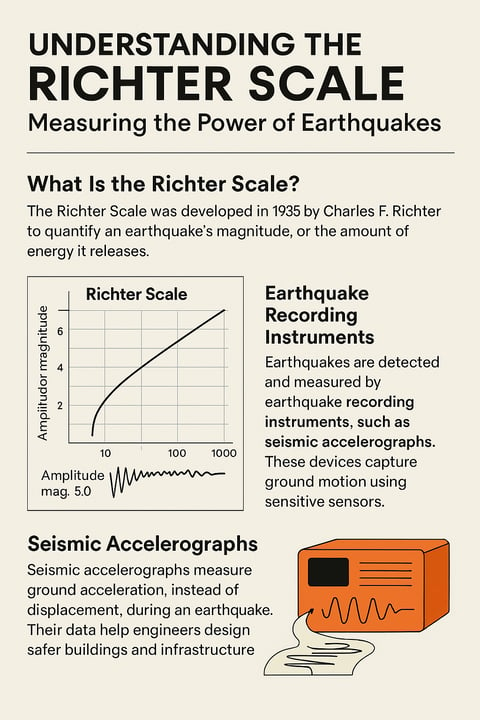Understanding the Richter Scale: Measuring the Power of Earthquakes
Earthquakes are among the most powerful and unpredictable natural phenomena on Earth. While they can be felt as small tremors or massive ground-shaking events, scientists rely on specific tools and scales to quantify their energy. One of the most well-known systems for measuring earthquake magnitude is the Richter Scale. Developed in the early 20th century, this scale remains a foundational concept in seismology. In this blog, we’ll explore what the Richter Scale is, how it works, and how modern earthquake recording instruments, such as seismic accelerographs, have evolved to enhance our understanding of seismic activity.
CG
4/6/20253 min read

What Is the Richter Scale?
The Richter Scale was developed in 1935 by American seismologist Charles F. Richter. It was the first quantitative scale for measuring the magnitude of earthquakes, which refers to the amount of energy released at the earthquake's source. Before this innovation, earthquakes were described primarily based on observed damage and human perception, which were highly subjective.
Richter’s system introduced a more scientific approach, using logarithmic calculations to determine magnitude. On this scale, each whole number increase represents a tenfold increase in measured amplitude and approximately 32 times more energy released. For example, a 6.0 magnitude earthquake releases about 32 times more energy than a 5.0 quake.
How Does the Richter Scale Work?
To calculate the magnitude of an earthquake, seismologists use data recorded by earthquake recording instruments. The original Richter Scale calculations relied on readings from a specific type of seismometer located in Southern California. The maximum amplitude of the seismic waves and the distance from the epicenter were the two key variables.
However, the original Richter Scale has limitations. It is most accurate for small to medium-sized earthquakes (typically under magnitude 7) and for events that occur within a limited geographical area. This is why modern seismology often uses more comprehensive scales, such as the Moment Magnitude Scale (Mw), which can more accurately measure large, global earthquakes.
Despite these advancements, the Richter Scale remains popular in public discourse because of its simplicity and historical significance.
The Role of Earthquake Recording Instruments
Accurate earthquake measurement would not be possible without earthquake recording instruments. These devices, which include seismometers, geophones, and seismic accelerographs, capture the vibrations caused by seismic waves traveling through the Earth. These waves originate from the earthquake’s focus and can travel thousands of kilometers.
Modern earthquake recording instruments are highly sensitive and capable of detecting even the slightest ground movements. They are deployed in dense networks across the globe and can record real-time data. This information is crucial for early warning systems, structural engineering, and earthquake research.
Some instruments are specifically designed to record low-frequency, long-period waves typical of large, distant earthquakes, while others capture high-frequency, short-period waves from local events. The combination of these tools helps scientists build a comprehensive picture of seismic activity.
Seismic Accelerographs: Precision in Motion
Among the many types of earthquake recording instruments, seismic accelerographs play a crucial role in modern seismology and engineering. Unlike traditional seismometers that measure ground displacement, seismic accelerographs measure ground acceleration. This is particularly important for assessing the effects of earthquakes on buildings, bridges, and other structures.
Seismic accelerographs are often installed in critical infrastructure such as hospitals, dams, and skyscrapers. When an earthquake occurs, these devices record the acceleration of the ground in three directions: vertical, north-south, and east-west. The data collected is used to determine the forces that structures must withstand during seismic events.
Moreover, seismic accelerographs are essential for the calibration and validation of building codes. Engineers use the information to simulate earthquake forces and design safer, more resilient buildings. Their role has become increasingly important in urban areas where the potential damage from earthquakes is high.
Evolution Beyond the Richter Scale
While the Richter Scale laid the groundwork for understanding earthquake magnitude, it is not the only tool in the seismic toolbox. The Moment Magnitude Scale (Mw) has largely replaced the Richter Scale in scientific contexts because it provides a more accurate representation of an earthquake’s energy release, especially for large events.
The Moment Magnitude Scale considers the fault rupture area, the amount of slip on the fault, and the rigidity of the rocks involved. These parameters are often derived from data collected by advanced earthquake recording instruments, including seismic accelerographs. This integration of technology ensures that scientists can provide more reliable magnitude estimates across different regions and types of earthquakes.
Nevertheless, the Richter Scale remains a valuable educational tool. It serves as an entry point for the general public to understand earthquake magnitudes and encourages greater interest in seismic safety.
Conclusion
The Richter Scale revolutionized the way we measure and understand earthquakes. Though it has been largely superseded by more modern scales, it still plays a key role in public communication about seismic events. Behind every Richter number lies a complex network of earthquake recording instruments, including seismic accelerographs, working tirelessly to record, analyze, and interpret the Earth’s movements.
As we continue to improve our technology and expand our understanding of seismic behavior, these instruments will remain at the forefront of earthquake science. Whether you're an engineer, a city planner, or simply a curious citizen, knowing how earthquakes are measured—and the tools behind those measurements—empowers us all to live more safely in a dynamic and ever-shifting world.


Contact us
Whether you have a request, a query, or want to work with us, use the form below to get in touch with our team.


Visit Us
10 OP Cyberone Building
11 Eastwood Avenue
Eastwood Bagumbayan
1110 Quezon City
Philippines
Social Media
Metro Manila (+63) 919-296-5410
info@ambraseys.ph
Visayas & Mindanao (+63) 906-577-6739 vismin@ambraseys.ph
